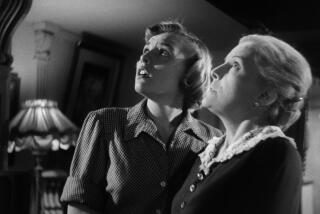‘Sunrise’s’ Lasting Shine
- Share via
Many call it the greatest silent film ever made; some even call it the greatest film ever made. So it is with great anticipation and excitement that F.W. Murnau’s “Sunrise” finally makes its long-awaited home-video premiere this week in a stunning laserdisc edition from Image Entertainment (courtesy of Fox Home Entertainment).
Thanks must go to the tireless film historian, restorer and laserdisc producer David Shepard for making it all possible with persistence and dedication. He found the best 35-millimeter elements available to make the digital transfer (utilizing the proper aspect ratio for optimal vertical information) and commissioned a new score by Timothy Brock that is a haunting complement to this landmark film that has mesmerized viewers for the past 70 years. (Also included on an analog track, incidentally, is the original Movietone score by Hugo Riesenfeld.)
For good measure, the laserdisc contains an extra 10 minutes of additional footage (unused moments, alternate takes and scenes from Murnau’s original script in English and German) that is sure to amplify the film’s scholarship.
Made at the dawn of the sound era, “Sunrise” proved to be the apex of silent filmmaking--incorporating the best that Hollywood had to offer with one of Germany’s most innovative directors. Fresh from his two triumphant masterpieces, “Faust” and “The Last Laugh,” Murnau, the middle-aged wonder, was wooed by William Fox and given complete artistic control.
Evidently it was Fox’s desire not only to expand his production and distribution prowess but to improve his studio’s prestige with a little art as well. And that’s exactly what he got with “Sunrise,” a simple fable of infidelity along the lines of “An American Tragedy”--directed by Murnau in the most visually intricate manner the cinema had yet seen.
There’s a probing camera that acts like an omniscient character, Art Deco interiors that provide modern perspective, Expressionistic lighting and latticed patterns that suggest spiritual transcendence, overlapping imagery that reveals overwrought states of mind and an emphasis on off-screen space that provides peripheral dramatic detail.
Based on a short story by Hermann Sudermann and adapted by Germany’s best screenwriter, Carl Mayer (“The Last Laugh,” “The Cabinet of Dr. Caligari”), “Sunrise” depicts the rebirth of a marriage between two peasant farmers (the girlish Janet Gaynor and the brooding George O’Brien).
Tempted by his seductive mistress from the city (Margaret Livingston) to murder his wife in a boating “accident,” O’Brien can’t go through with the plan, and must
win his wife all over again when she flees to the city in a streetcar.
Gaynor and O’Brien rediscover their love in the busy urban metropolis during an episode of sweet intimacy and innocent pleasure (with performances that are lyrical). However, on their way home, under a romantic moonlit sky, their renewed bliss is disrupted by a raging storm that nearly fulfills the illicit plan. But Gaynor is ironically saved by O’Brien’s symbol of deceit, the bulrushes he has stashed in their boat.
Judging from Murnau’s comments upon his arrival in the United States, he also had a lot more on his mind than making a typical Hollywood film: “Our whole effort must be bent toward ridding motion pictures of all that does not belong to them--all the tricks, gags, business not of the cinema, but of the stage and the written book. That is what has been accomplished when certain films reached the level of great art.”
Murnau certainly achieved this with “Sunrise,” which influenced filmmakers around the world for decades (including Alfred Hitchcock and Saul Bass, who used the main title design of the glass building for “North by Northwest”).
One of the most celebrated moments is the erotic rendezvous in the marshes, daring for its time and still powerful: The camera follows O’Brien for a while, then leaves him to locate the vampish Livingston twirling a flower under the moonlight. He eventually finds her and she reduces him to a child with her lusty advances.
By contrast, there’s the reconciliation between husband and wife, starting out softly and sublimely in a church, then culminating with a sensational evening at a carnival that’s surreal in its design and activity. The synchronized music and effects on the original soundtrack display part of the future potential of the new technology.
Yet despite--or maybe because of--such innovations, “Sunrise” was a disaster when it opened in 1927. The majority of American critics turned on Murnau, calling his visual pyrotechnics “exotic” and his overall production “excessive.” (Does this sound familiar, James Cameron?)
Apparently the mixture of Murnau and Hollywood was too confusing. Critics preferred the German director advancing the film medium at his UFA studio in Berlin rather than at Fox. But the backlash wasn’t confined to Murnau;there was general resentment of German competition from abroad.
Meanwhile, the public was unresponsive as well, preferring Gaynor in Fox’s more accessible “Seventh Heaven,” directed the same year by the ultimate romantic, Frank Borzage. It didn’t help, of course, that Murnau barred journalists from his set, or that Fox’s publicity department was clueless about handling what was essentially one of America’s first art films.
But all was not lost: Gaynor won the first best actress Oscar for her performances in “Sunrise” as well as “Seventh Heaven” and Borzage’s “Street Angel.” And “Sunrise” earned additional Academy Awards for cinematography and “artistic quality of production.”
Full vindication began 25 years later (too late for Murnau, who died in a car crash in 1931 at the age of 43). Viewed today, “Sunrise” seems remarkably fresh and modern in its wise depiction of human frailty and the ambiguity of good and evil in even the simplest people.
Its complex narrative is far from exotic. On the contrary, it’s the perfect choice for this love story. The style, in fact, defines the content with a poetry unique to silent film (typically for Murnau, few intertitles were required to tell the story).
So it’s no wonder that the subtitle for “Sunrise” is “A Song for Two Humans.” Yet without realizing it, Murnau did more than rid the cinema of arcane theatrical and literary conventions. Like a handful of other pioneers, he established ingenious visual equivalents.
More to Read
Only good movies
Get the Indie Focus newsletter, Mark Olsen's weekly guide to the world of cinema.
You may occasionally receive promotional content from the Los Angeles Times.










